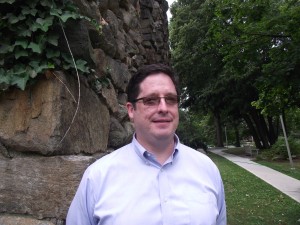
On the Pace Law School campus in White Plains, Franz T. Litz began a new job last month that brings him into the stormy climate surrounding the Indian Point nuclear power plant and its continued operation.
“The debate is really heating up,” Litz said of the Indian Point issue in his new office as executive director of the Pace Energy and Climate Center. An attorney who has worked in energy and environmental law in both the public and private sectors ”“ most recently at the World Resources Institute, a Washington, D.C., think tank ”“ at the Pace center he heads a 12-member staff that conducts policy analysis and legal research to promote investment in and use of clean and sustainable energy technologies.
The debate pits Indian Point”™s owner and operator, Entergy Corp., and supporters of its federal relicensing, including several business and labor groups in the metropolitan region, against a host of environmental groups and anti-nuclear power opponents that want the Buchanan plant closed. They latter factions cite public health and safety risks to a vast population. The opposition most notably includes the state of New York and Gov. Andrew Cuomo, who has served notice to Entergy officials that he intends to shut down the Westchester plant.
Cuomo this month signed into law the Power New York Act, a bill that regulates new power-plant sitings in the state. State officials have said the law will aid in efforts to close Indian Point and replace its nuclear power with alternative energy sources.
If Indian Point is closed, “I don”™t think they have given us any indication of how to replace it,” Litz said of state officials. Plant opponents “should think about the alternatives.” At the Pace Energy and Climate Center, which has stayed neutral on the Indian Point issue, “We want to influence that consideration” in Albany, he said.
Litz, a former attorney at the state Department of Environmental Conservation, said the center plans in the next six months to prepare a report examining possible approaches to replacing Indian Point and its 2-megawatt generating capacity.
“We try to be as objective as possible when examining the different options that are available from an environmental and cost perspective,” he said. “In this case, I think we”™re talking about trying to weigh a bunch of options to come up with the right mix.
“There”™s a fairly finite list of options for replacement.”
Litz said they include rooftop solar power, new natural gas plants in New York and greater reliance on coal- and gas-fired power plants in Pennsylvania.
“Natural gas right now is very cheap, but you”™d be locked in to the whims of the market” and still dependent on fossil fuel, he said. Drawing replacement power from Pennsylvania plants would add to the region”™s high air-pollution levels.
“What are the opportunities for this area? If Cuomo shuts the plant down, is that going to bring economic opportunities to the region and stimulate job growth in the region through energy efficiencies in business and residential space?” The Pace report will examine those potential opportunities.
“Energy infrastructure is a huge potential source of jobs,” Litz said. “These are durable jobs, these are skilled jobs” that will be needed to make homes and companies more energy-efficient.
Litz said he will teach a course on climate change law next spring at Pace Law School, long known for its environmental law studies. Climate change “is a burgeoning area of law that essentially is multidisciplinary,” he said.
Founded in 1987 by former U.S. Congressman Richard L. Ottinger, dean emeritus of Pace Law School, the energy and climate center “allows Pace law students to roll up their sleeves and actually see how the energy law comes into play,” said Litz. “We hope to continue a really practical tradition of having lawyers see what it”™s all about, not just in the books.”



















Before talking about the difficulties or replacing IP’s power, let’s see where their output is being sold, as a New York State Assemblyman has requested from the company. The ConEd annual report shows that only 350MW of IP output are contracted directly to ConEd. With anothr 200MW contracted to NYPA and then resold to ConEd, 550 – 560MW are going to the SENY grid (Southesat New York)through contract. If te remainder is being sold upstate or to other grids, the replacement argument becomes a lot different.